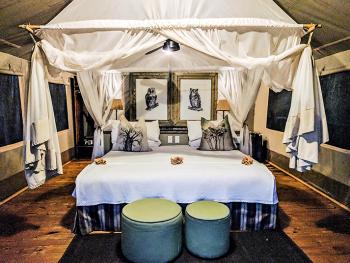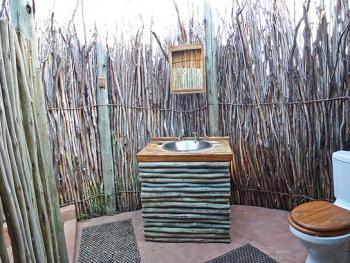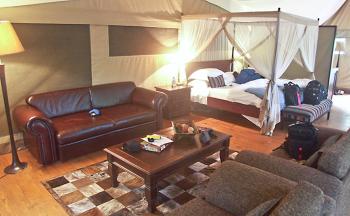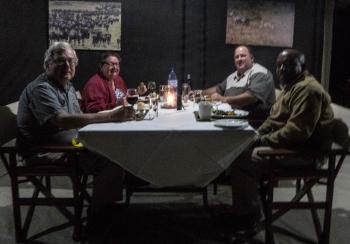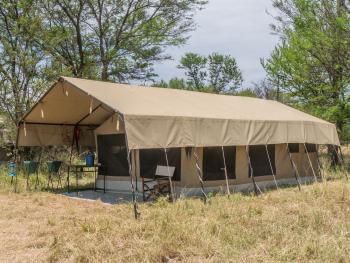Safari lodges and camps in Africa — what to expect
This item appears on page 13 of the October 2021 issue.
Because the idea of going to Africa may be a bit intimidating to many people, we thought a primer, of sorts, might be appreciated. We previously wrote about game-drive photo safaris (July ’21, pg. 12). This time, the information is intended to provide a feel for the types of camps and lodges we have stayed at and visited in Africa, having completed our seventh trip there in March 2020.
We describe five types, chosen for variety. While each of the descriptions is primarily about one accommodation, somewhat augmented and generalized, please don’t look for them on the internet by name. We’ve made up the lodge and camp names, based on the Big Five, to create representations of, in most cases, multiple lodges or camps that share similar features in each location.
Our experiences have been in Kenya (Masai Mara National Reserve), Tanzania (Ngorongoro Conservation Area and Serengeti National Park), South Africa (Kruger and Mapungubwe national parks), Zimbabwe (Matobo National Park), Botswana (Mashatu Game Reserve) and Namibia (Etosha National Park and Okonjima Nature Reserve).
•
• Our first representative camp, “Buffalo River Lodge,” is typical of several lodges that can be found in northeastern South Africa on private reserves adjoining and connected to Greater Kruger National Park, with no fences.
There, a main lodge with a large deck is a short walk from individual tented rooms and thatched chalets, completely separated for privacy.
If the phrase “tented room” makes you think of the Boy Scouts, you couldn’t be more wrong! The units have canvas sides and are built on raised wooden decks, with outside areas where people can sit. At the rear of each is a large bathroom area with a modern sink, tub and shower. There also is a private outside shower, sometimes overlooking a river. (One morning at one such lodge, two young Cape buffalo casually inspected George’s shower activities.)
The tents have overhead heaters/air-conditioners with remote control. The bedroom furniture and bedding rival those of any luxury hotel.
• The second type, “Camp Elephant,” describes accommodations that can be found in southern South Africa, a 4-hour drive from Cape Town and just off the popular Garden Route.
Meals are served in a central lodge, and there are individual tented lodges, luxuriously furnished, on raised wooden platforms. They are very similar to those at “Buffalo River Lodge” and are also air-conditioned. Our tent had leather furniture and Africa-themed throw pillows. Oriental rugs completed the décor. There was a soaking tub on the deck.
When deciding where to go in a big country and what to see, travel is always a tradeoff. “Camp Elephant” has brought animals from Kruger Park — over 1,000 miles away from the Garden Route — to its guests. It is perhaps unfair to call the camp’s reserve an open-air zoo; at only 16 square miles, it’s too small to have a real animal ecosystem. But the camp is fun.
The animals there are mostly the same as you’d see up north but more “domesticated.” Morning “Tea with the Elephants,” for example, gets you to within petting distance. The lions are rescues and don’t hunt; they’re fed by the lodge. Other popular animals there (like giraffes, rhinos and Cape buffalo, most of them rescues) are also “on staff.”
• In Tanzania, in what we’re calling “Rhino Lodge,” “tented” really does mean tents. They’re large, with canvas floors and zippered doors, but inside each are comfortable 4-poster twin beds, with a dressing table in the front and a Western-style toilet and large shower stall in the rear “room.”
In front of them are canvas verandas, each equipped with a table, sink and water for washing clothes. A solar panel for each tent provides power for a battery, so lighting after dark is quite limited.
All water is trucked in and out. A shower is arranged by scheduling hot water for your overhead (canvas) shower tank. The flush tank for the toilet is automatically kept filled.
Buffet-style meals are served in the dining tent, and comfortable chairs in front of the dining and kitchen tents are perfect for watching animals that wander by.
Places like this can be found in the northern part of Serengeti National Park (www.serengeti.com). A major attraction there is the Great Migration, a seasonal movement of some 2 million wildebeest and a million zebras from the south in Tanzania to the north in Kenya and back again. Predators along the route make a good living from the migration. These include crocodiles in the Mara River as well as big cats.
• The fourth type of accommodation, what we’ll call “Lion Gardens,” is a complex of villas, coffee trees and vegetable and flower gardens centered around a large lodge. At the end of a 45-minute bucking-horse ride down a rutted and potholed dirt road, it looks like a country club and is a true miracle on the savannah.
Teeming with wildlife, “Lion Gardens” is on the rim of Ngoron goro Crater. The grounds feature resident peacocks and storks. The villas are beautiful — little stone studio apartments sans kitchens.
A luxurious stop like this is great for relaxing and decompressing in the middle of a multiweek trip. On our visit to such a complex, we had our own vehicle with a guide/driver, so it was a great location to use as a base.
• Our final category, let’s label it “Leopard Lake Lodge,” is one of the more unusual types of lodges we have experienced. Developed by the local Maasai community with support from outside investors, these facilities are primitive but comfortable. Service is sincere but sometimes not highly polished. (In other words, just right.)
“Leopard Lake Lodge” is great fun because of the accommodations. Guest tents are on hand-molded concrete platforms that incorporate tree branches and logs for structure and handrails. Inside, the shower/bathtub and sink are hand-molded, with gracefully curved tree branches defining their shapes. Everything is gaily painted in bright colors. It feels like living in an artist’s sculpture (with no electricity).
This place is near Lake Natron, a mineral-rich soda lake inhabited by red algae, the food source for algae-red flamingos. Visitors to this area also might opt, as we did, to tour a nearby Maasai village. The beadwork worn by both the men and women is amazingly intricate.
•
Other camps and lodges — The five lodge types we’ve described are basically mid-market to up-market options, but there are choices both more budget-friendly and more luxurious than those we’ve experienced.
NATIONAL PARK REST CAMPS normally offer a variety of accommodations all in one place, from a basic RV park to a basic but comfortable self-catering chalet.
When compared to private camps, park accommodations are normally quite cheap but offer very little in the way of services. For example, a chalet in Kruger National Park is a basic unit with en suite bath and probably air-conditioning. However, rooms are built facing each other in large circles and offer no meals, not even a tea-and-coffee station in the room.
You need to do or arrange your own game drives and either cook for yourself or eat in the basic camp restaurant. On game drives, you’re limited to the road network along with every other car in the park (and game sightings on the main roads can get very congested).
At the other end of the spectrum, ULTRALUXURY CAMPS go over the top in every way, from having private airstrips to providing a butler for each room. Each meal is not just cooked for you but is designed for you.
Price is not always a good indicator of how good a lodge is, however. You could choose a simple guest house and have a better stay than at a 5-star lodge that misses the mark.
As a rule of thumb, lodges run by owners or staff with a vested interest in seeing service delivery will always be better than a lodge run by employees for distant owners. In all these matters, TripAdvisor (www.tripadvisor.com) is your friend.
We thank our frequent guide and friend Pierre Duval of BushBaby Safaris (Dundee, South Africa; www.bushbaby.co.za) for reviewing this text and contributing information on the “other camps and lodges.”
We would be happy to answer questions via email, phone or even video conference. You can reach us through ITN (editor@intltravelnews.com or write c/o ITN, 2122 28th St., Sacramento, CA 95818).
GEORGE & SANDRA ANDERSON
Minneapolis, MN

